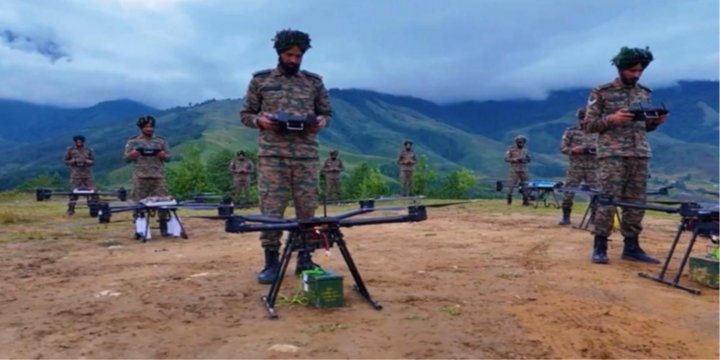EXERCISE SIYOM PRAHAR (2025)
- The Indian Army successfully conducted Exercise Siyom Prahar from 8th to 10th September 2025, a major field training exercise focused on integrating drones into tactical and operational combat roles.
- The exercise marked a significant advancement in India’s military preparedness, emphasizing the use of unmanned aerial systems (UAS) for surveillance, reconnaissance, target acquisition, and precision strikes.
- It reflects the Army’s future-oriented doctrine to adapt to technology-centric modern warfare.
AIMS & OBJECTIVES
- Validate drone deployment in actual battlefield conditions.
- Develop and test new Tactics, Techniques and Procedures (TTPs) for:
- Drone-based surveillance & targeting
- Precision strike integration
- Real-time intelligence fusion
- Enhance decision-making speed and accuracy in high-tempo combat.
- Strengthen synergy between traditional combat arms and new tech enablers.
KEY FEATURES & HIGHLIGHTS
1. Tactical Use of Drone Technology
| Capability | Purpose |
| Persistent Surveillance | 24/7 real-time monitoring of enemy activities |
| Battlefield Reconnaissance | High-resolution mapping, terrain assessment |
| Target Acquisition | Laser/GPS-guided marking for artillery and missile systems |
| Precision Strikes | Armed drones used to engage high-value enemy targets |
2. Development of New TTPs
- Fusion of real-time drone data with conventional firepower
- Refined joint targeting protocols (coordination between UAVs, artillery, infantry)
- AI-supported quick decision cycles
- Drone use in both offensive and defensive tactical scenarios
3. Operational Themes
- Emphasis on network-centric warfare
- Integration with satellite communication and GPS-based coordination
- Cybersecurity & EW considerations during drone operations
- High-speed communication between UAV teams, fire support units, and command posts
STRATEGIC SIGNIFICANCE
1. Force Multiplication
- Reduced need for human reconnaissance teams in high-risk areas
- More efficient resource allocation
2. Enhanced Combat Readiness
- Real-time intel and drone-assisted precision enables proactive strike capability
3. Military Modernization
- Supports India’s shift toward tech-driven, multi-domain warfare
- Part of Indian Army’s Integrated Battle Group (IBG) concept and future-ready doctrine
INDIA’S DRONE WARFARE INITIATIVES
| Initiative | Details |
| Loitering Munitions Acquisition | DRDO + Solar Industries |
| Swarm Drone Projects | Army using swarms from private Indian startups |
| Drone Policy & Doctrine | Integration under Army’s ‘Army Technology Perspective and Capability Roadmap (TPCR)’ |
| Indigenous Production | Part of Atmanirbhar Bharat and Make in India (Defence) campaigns |
EVOLUTION OF DRONE WARFARE
- WWII & Korean War: Initial UAV usage for training and limited strikes.
- 1991 Gulf War: Modern military deployment began.
- 2020 Nagorno-Karabakh War: Game-changing use by Azerbaijan with Bayraktar TB2 & Harop drones.
- Other conflicts:
- Yemen: Houthi rebels used drone swarms.
- Gaza: High-tech drones by Israel; grenades/observation by Hamas.
- Ukraine War: Drones used for recon, attack (e.g., Shahed-136, FPVs, loitering munitions).
Drone Swarms: The New Threat
- Operate autonomously or semi-autonomously in coordination.
- Used for:
- Saturating defences
- Gathering intelligence
- Targeting high-value assets
- More resilient than traditional drones — even if some are intercepted.
KEY CHALLENGES
- Low-cost drones ($1,000) can damage high-cost targets ($200M aircraft).
- Defending against them is expensive and complex.
- Porous borders make countries like India more vulnerable.
INDIA’S DEFENCE & COUNTER DRONE STRATEGY
Systems in Use
- Akashteer System: Integrates radar and command network.
- Bhargavastra: Fires 64 micro-rockets for swarm neutralisation.
- DRDO Anti-Drone System:
- 360° radar coverage.
- Soft kill (jamming) + hard kill (laser).
- Detects drones at 4 km; neutralises at 1 km.
- Indrajaal Grid: AI-powered; protects up to 4,000 sq km. Combines spoofing, jamming, intelligence.
GLOBAL DRONE & ANTI DRONE TRENDS
- Global Military Drone Market:
- $14.14B (2023) → $47.16B (2032) (Fortune Business Insights)
- Emerging Technologies:
- AI-driven drone swarms
- Directed Energy Weapons (DEWs): Lasers & microwaves.
- Electronic Warfare (EW): Jamming and spoofing.
- Cyber Attacks: Hijack drones via software exploits.
- Interceptor drones & nets for close-range defense.
LOOKING AHEAD
- India has:
- Over 550 drone-tech startups.
- Growing indigenous tech alongside global acquisitions.
- The future battlefield will be unmanned, AI-driven, and asymmetric.
- Emphasis on layered defence systems integrating multiple interception methods (like Iron Dome, M-SHORAD in the US).
CONCLUSION
Exercise Siyom Prahar represents a major leap in India’s journey toward technology-led military modernization. By integrating drones into frontline tactical operations, the Indian Army is not only enhancing its combat preparedness but also aligning with future warfare doctrines. The lessons from this exercise will inform doctrinal evolution, procurement strategy, and force structure transformation in the coming years.
Note: Connect with Vajirao & Reddy Institute to keep yourself updated with latest UPSC Current Affairs in English.
Note: We upload Current Affairs Except Sunday.

